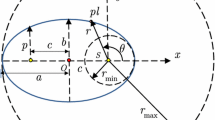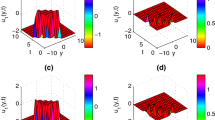Abstract
In this investigation, an answer is given to the question of whether Newton’s law of motion is of integer or non-integer, i.e., fractional, order differential form. The answer is given by seeking Newton’s law of motion in the form of a fractional differential operator. Then, applying an identification procedure using separately virtual Galileo’s experimental data on the inclined plane and Kepler’s laws of planetary motion, the fractional differential operator is established yielding the equation of motion. Both identifications yield the law of motion in the form of a fractional differential equation, which is converted into a second-order differential equation, verifying thus that for a body with constant mass Newton’s law of motion is indeed of integer differential form.


Similar content being viewed by others
Notes
U(s) represents the Laplace transform of the function u(t), \(t\ge 0\), defined by \(U(s)=\int _0^\infty {u(t)e^{-st}dt} \), where s is the Laplace variable.
The units that have been used in the identification procedure are: second (s) for time; meter (m) for distance; kN for force; m/\(\hbox {s}^{2 }\)for acceleration; \(\hbox {kNs}^{2}\)/m for mass.
References
Newton, I.: Philosophiae Naturalis Principia Mathematica. Royal Society Press, London (1686)
Newton, I.: The Mathematical Principles of Natural Philosophy; Translated into English by Andrew Motte, published by Daniel Adee, New York (1846)
Coelho, R.L.: On the deduction of Newton’s second law. Acta Mech. 229(5), 2287–2290 (2018). https://doi.org/10.1007/s00707-017-2074-2
Katsikadelis, J.T.: Derivation of Newton’s law of motion using Galileo’s experimental data. Acta Mech. 226, 3195–3204 (2015). https://doi.org/10.1007/s00707-015-1354
Katsikadelis, J.T.: Derivation of Newton’s law of motion from Kepler’s laws of planetary motion. Arch. Appl. Mech. 88(2018), 27–38 (2017). 10.1007/s00419-017-1245-x
Katsikadelis, J.T.: System identification by the analog equation method. In: Brebbia, C.A. (ed.) Boundary Elements XVII, pp. 33–44. Computational Mechanics Publications, Southampton, Boston (1995)
Katsikadelis, J.T.: Numerical solution of variable order fractional differential equations (2018). arXiv:1802.00519 [math.NA]
Podlubny, F.: Fractional Differential Equations. Academic Press, New York (1999)
NASA Planetary Comparison Chart, http://solarsystem.nasa.gov/planets/compchart.cfm. (Retrieved 6 June 2015)
Author information
Authors and Affiliations
Corresponding author
Additional information
Publisher's Note
Springer Nature remains neutral with regard to jurisdictional claims in published maps and institutional affiliations.
Rights and permissions
About this article
Cite this article
Katsikadelis, J.T. Is Newton’s law of motion really of integer differential form?. Arch Appl Mech 89, 639–647 (2019). https://doi.org/10.1007/s00419-018-1486-3
Received:
Accepted:
Published:
Issue Date:
DOI: https://doi.org/10.1007/s00419-018-1486-3




